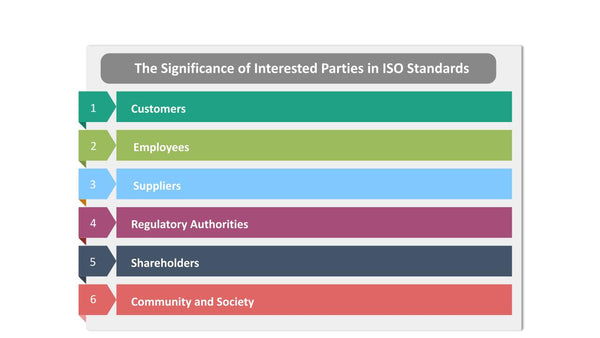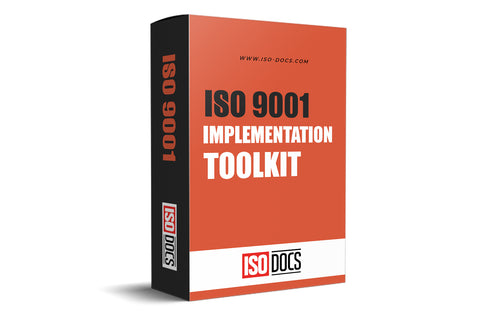The Significance of Interested Parties in ISO Standards
In today's rapidly evolving global landscape, the International Organization for Standardization (ISO) stands as a beacon of quality, safety, and efficiency across industries. ISO standards, far from being mere technical documents, serve as the bedrock of quality management systems that guide organizations towards excellence. At the heart of ISO standards lies a concept that is often overlooked but holds profound significance: interested parties. In this comprehensive exploration, we will journey into the world of ISO standards, gain a profound understanding of who these interested parties are, and explore deep into their pivotal role in shaping the operational ethos of organizations worldwide.

Understanding ISO
The International Organization for Standardization, or ISO, stands as an independent, non-governmental international body responsible for developing and publishing standards that underpin the quality, safety, and efficiency of products, services, and systems. ISO standards serve as the common language and framework through which organizations operate, facilitating international trade, fostering innovation, and safeguarding consumers and the environment.
ISO standards span an array of industries and sectors, encompassing manufacturing, healthcare, information technology, food safety, and environmental management. They provide the necessary guidelines for organizations to ensure that their products and services adhere to the mandated standards of quality and safety, facilitating trust and reliability in the global marketplace.
The Significance of Interested Parties in ISO Standards
Interested parties, as defined by ISO, comprise individuals or groups who possess a vested interest in an organization's performance or success. These stakeholders can either be internal or external to the organization and encompass a diverse spectrum of entities, including customers, employees, suppliers, regulatory authorities, shareholders, and the broader community.
- Customers: Customers stand as the linchpin of any organization's success. They are the ultimate end-users of products and services and demand adherence to stringent quality and safety standards. Contented customers become repeat patrons, advocates of the brand, while disgruntled customers can inflict lasting damage to an organization's reputation.
- Employees: Employees form the lifeblood of any organization. Their welfare, safety, and job satisfaction are pivotal to the success of the enterprise. ISO standards, such as ISO 45001 for Occupational Health and Safety Management, come into play to ensure organizations provide a secure and healthy work environment.
- Suppliers: Suppliers emerge as vital partners in an organization's supply chain. The quality of raw materials and components provided by suppliers directly influences the quality of the final product. ISO standards, particularly ISO 9001 for Quality Management Systems, empower organizations to nurture robust relationships with suppliers and guarantee the consistency of inputs.
- Regulatory Authorities: Government agencies and regulatory bodies establish standards and regulations to protect the public and the environment. Complying with these regulations often emerges as a legal mandate, with ISO standards serving as the bridge to help organizations meet these obligations.
- Shareholders: Shareholders and investors harbor a vested interest in the financial performance and long-term sustainability of the organization. ISO standards can contribute significantly to bolstering governance, risk management, and overall business performance, ultimately leading to an augmented shareholder value.
- Community and Society: Organizations function within a broader societal context, and their actions can wield a substantial impact on the community and the environment. ISO standards, exemplified by ISO 14001 for Environmental Management, enable organizations to curtail their environmental footprint and actively participate in sustainable development.
The Multifaceted Significance of Interested Parties in ISO Standards
Now that we have identified the spectrum of interested parties, it is paramount to elucidate why they wield such profound significance in the realm of ISO standards.
- Customer-Centric Approach: ISO standards place unwavering emphasis on the necessity of fulfilling customer requirements and amplifying customer satisfaction. By incorporating customers as integral interested parties, organizations are compelled to center their efforts on delivering high-quality products and services that not only meet but exceed customer expectations.
- Risk Management: The identification and mitigation of risks are integral facets of ISO standards. Organizations that overlook the interests of their stakeholders may unwittingly expose themselves to legal, financial, or reputational risks. ISO standards, for instance, ISO 31000 for Risk Management, provide a structured roadmap for assessing and mitigating risks associated with interested parties.
- Continuous Improvement: A culture of continuous improvement is an inherent feature of ISO standards. By actively engaging with interested parties and soliciting feedback, organizations can identify areas ripe for enhancement and swiftly implement changes that bolster their overall performance.
- Legal Compliance: Many ISO standards are meticulously designed to guide organizations in fulfilling legal and regulatory obligations. By duly acknowledging the interests of regulatory authorities and other stakeholders, organizations can operate within the confines of the law, mitigating potential legal repercussions.
- Sustainability and Social Responsibility: ISO standards have evolved to embrace sustainability and social responsibility issues. Factoring in the interests of the community and society at large, organizations can cultivate practices that minimize their ecological footprint and actively contribute to societal betterment.
- Competitive Advantage: Organizations that proactively prioritize the interests of their stakeholders are well-positioned to gain a competitive edge. Contented customers, motivated employees, and robust supplier relationships can translate into amplified market share and enhanced profitability.
Conclusion
The inclusion of interested parties in ISO standards is a fundamental driver of organizational success. These stakeholders, from customers and employees to regulatory bodies and the community, shape the landscape in which organizations operate. ISO standards provide a structured approach for organizations to engage with and fulfill the needs and expectations of these parties. This leads to customer satisfaction, risk management, legal compliance, and sustainability. Recognizing the importance of interested parties in the ISO framework is essential for organizations seeking excellence, competitive advantage, and long-term viability. In an age where corporate responsibility is paramount, ISO standards underscore the path toward achieving organizational goals while making a positive impact on society and the global economy.


